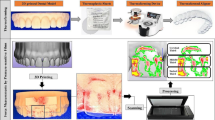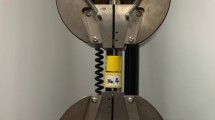Abstract
Aim
To determine the influence of two all-in-one self-etching adhesive systems on shear bond strength of a fissure sealant applied under different enamel surface conditions.
Methods
A total of 180 bovine enamel specimens were randomly distributed to nine experimental groups, defined by the combination of the sealant application technique (using phosphoric acid, or a self-etching water-based adhesive or a self-etching ethanol and water-based adhesive) and enamel surface conditions (dry enamel, saliva or water contaminated enamel). The specimens were submitted to thermocycling prior to the shear bond strength test.
Results
High shear bond strength mean values were obtained with the classic technique for dry enamel (31.47 MPa), statistically similar values were obtained when the sealant was combined with a self-etching water-based adhesive, in dry enamel (32.36 MPa), and when the sealant was combined with a self-etching water-based adhesive in water contaminated enamel (32.62 MPa). Under enamel salivary contamination, the best results were achieved using a water-based adhesive (24.78 MPa).
Conclusions
In saliva contaminated enamel, the combination of a sealant with a water-based self-etching adhesive can maintain high and satisfactory values of bond strength.


Similar content being viewed by others
References
Al-Sarheed MA. Evaluation of shear bond strength and SEM observation of all-in-one self-etching primer used for bonding of fissure sealants. J Contemp Dent Pract. 2006;7(2):9–16.
Anusavice KJ, Brantley WA. Physical properties of dental materials. In: Anusavice KJ, editor. Phillips’ science of dental materials. 11th ed. St. Louis: Elsevier Science; 2003. p. 41–71.
Asselin M, Sitbon Y, Fortin D, Abelardo L, Rompre PH. Bond strength of a sealant to permanent enamel: evaluation of 3 application protocols. Pediatr Dent. 2009;31(4):323–28.
Barkmeier W, Cooley R. Laboratory evaluation of adhesive systems. Oper Dent. 1992;5(Suppl):50–61.
Barroso JM, Torres CP, Lessa FCR, et al. Shear bond strength of pit-and-fissure sealants to saliva-contaminated and noncontaminated enamel. J Dent Child (Chic). 2005;72(3):95–9.
Bogert TR, García-Godoy F. Effect of prophylaxis agents on the shear bond strength of a fissure sealant. Pediatr Dent. 1992;14(1):50–1.
Choi JW, Drummond JL, Dooley R, Punwani I, Soh JM. The efficacy of primer on sealant shear bond strength. Pediatr Dent. 1997;19(4):286–8.
De Munck J, Van Landuyt K, Peumans M, et al. A critical review of the durability of adhesion to tooth tissue: methods and results. J Dent Res. 2005;84(2):118–32.
Ernst CP. Positioning self-etching adhesives: versus or in addition to phosphoric acid etching? J Esthet Restor Dent. 2004;16(1):57–69.
Gomes-Silva JM, Torres CP, Contente MMMG, et al. Bond strength of a pit-and-fissure-sealant associated to etch-and-rinse and self-etching adhesive systems to saliva-contaminated enamel: individual vs. simultaneous light curing. Braz Dent J. 2008;19(4):341–7.
Gordan VV, Vargas MA, Cobb DS, Denehy GE. Evaluation of adhesive systems using acidic primers. Am J Dent. 1997;10(5):219–23.
Hobson RS, McCabe JF. Relationship between enamel etch characteristics and resin-enamel bond strength. Br Dent J. 2002;192(8):463–8.
Ibarra G, Vargas MA, Geurtsen W. Interfacial and surface characterization of two self-etching adhesive systems and a total-etch adhesive after bonding to ground and unground bovine enamel—a qualitative study. Clin Oral Investig. 2006;10(4):331–41.
Jain P, Stewart GP. Effect of dentin primer on shear bond strength of composite resin to moist and dry enamel. Oper Dent. 2000;25(1):51–8.
Knobloch LA, Meyer T, Kerby RE, Johnston W. Microleakage and bond strength of sealant to primary enamel comparing air abrasion and acid etch techniques. Pediatr Dent. 2005;27(6):463–9.
Krifka S, Borzsonyi A, Koch A, et al. Bond strength of adhesive systems to dentin and enamel—human vs. bovine primary teeth in vitro. Dent Mater. 2008;24(7):888–94.
Kugel G, Ferrari M. The science of bonding: from first to sixth generation. J Am Dent Assoc. 2000;131(Suppl):20S–25S.
Miyazaki M, Sato M, Onose H. Durability of enamel bond strength of simplified bonding systems. Oper Dent. 2000;25(2):75–80.
Nakamichi I, Iwaku M, Fusayama T. Bovine teeth as possible substitutes in the adhesion test. J Dent Res. 1983;62(10):1076–81.
Ostby AW, Bishara SE, Denehy GE, Laffoon JF, Warren JJ. Effect of self-etchant pH on the shear bond strength of orthodontic brackets. Am J Orthod Dentofac Orthop. 2008;134(2):203–8.
Pashley DH, Tay FR. Aggressiveness of contemporary self-etching systems. Part II: etching effects on unground enamel. Dent Mater. 2001;17(5):430–44.
Perdigão J, Lopes L, Lambrechts P, et al. Effects of a self-etching primer on enamel shear bond strengths and SEM morphology. Am J Dent. 1997;10(3):141–6.
Peumans M, Kanumilli P, De Munck J, et al. Clinical effectiveness of contemporary adhesives: a systematic review of current clinical trials. Dent Mater. 2005;21(9):864–81.
Peutzfeldt A, Nielsen LA. Bond strength of a sealant to primary and permanent enamel: phosphoric acid versus self-etching adhesive. Pediatr Dent. 2004;26(3):240–4.
Silverstone LM. State of art on sealant research and priorities for further research. J Dent Educ. 1984;48(2 Suppl):107–18.
Soderholm KJ, Soares F, Argumosa M, et al. Shear bond strength of one etch-and-rinse and five self-etching dental adhesives when used by six operators. Acta Odontol Scand. 2008;66(4):243–9.
Torres CP, Balbo P, Gomes-Silva JM, et al. Effect of individual or simultaneous curing on sealant bond strength. J Dent Child (Chic). 2005;72(1):31–5.
Townsend RD, Dunn WJ. The effect of saliva contamination on enamel and dentin using a self-etching adhesive. J Am Dent Assoc. 2004;135(7):895–901.
Van Landuyt KL, Peumans M, De Munck J, Lambrechts P, Van Meerbeeck B. Extension of a onestep self-etch adhesive into a multi-step adhesive. Dent Mater. 2006;22(6):533–44.
Van Meerbeeck B, Yoshihara K, Yoshida Y, et al. State of the art of self-etch adhesives. Dent Mater. 2011;27(1):17–28.
Author information
Authors and Affiliations
Corresponding author
Ethics declarations
Conflict of interest
The authors deny any conflicts of interest.
Rights and permissions
About this article
Cite this article
Coelho, A., Canta, J.P., Martins, J.N.R. et al. Influence of self-etch all-in-one adhesives on fissure sealant shear bond strength under contaminated enamel conditions. Eur Arch Paediatr Dent 20, 15–22 (2019). https://doi.org/10.1007/s40368-018-0378-0
Received:
Accepted:
Published:
Issue Date:
DOI: https://doi.org/10.1007/s40368-018-0378-0




